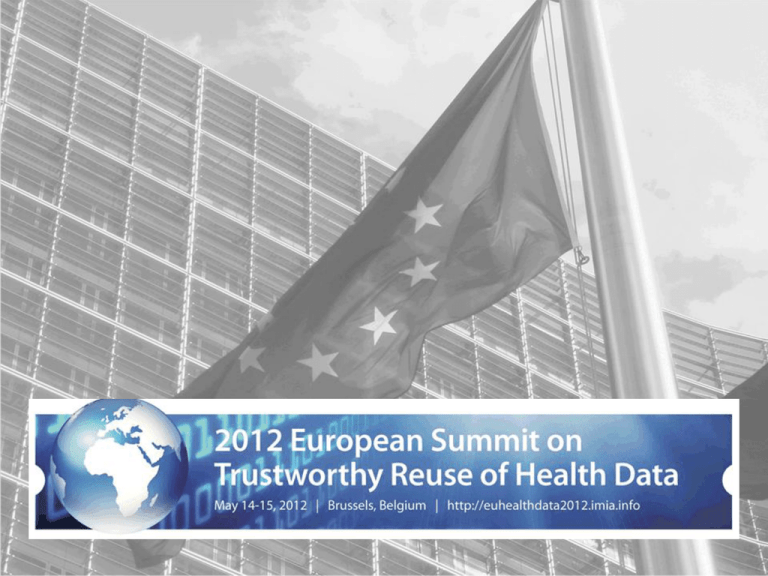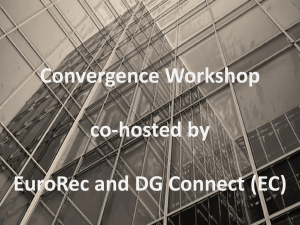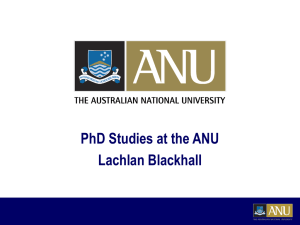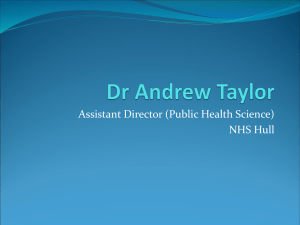Trustworthy Reuse of Health Data “Perspective from the EU”
advertisement

Georges De Moor, MD, PhD 1 Brussels, 14-15 May 2012 Trustworthy Reuse of Health Data “Perspective from the EU” Prof. Dr. Georges De Moor, Ghent University, Belgium EuroRec President European Institute for Health Records Georges De Moor, MD, PhD 2 Brussels, 14-15 May 2012 The European Continent and the E.U. Only “European” part of Russia and Turkey included From Wikipedia, the free encyclopedia Georges De Moor, MD, PhD 3 Brussels, 14-15 May 2012 Europe Figures for the population of Europe vary according to which definition of European boundaries is used. According to the United Nations, the population within the standard physical geographical boundaries is about 720 million using the definition which has been used for centuries. The European Union (E.U.) population is about 500 million. There are 27 E.U.- Member States and each is responsible for its own National Health System (cf. subsidiarity principle). There is no central Health Authority in Europe. 17 countries have adopted the Euro as currency: they constitute together the Eurozone. The languages of the European Union are languages used by people within the member states of the European Union. They include the 23 official languages of the European Union along with a range of others. The most widely spoken mother tongue in the EU is German, while 51% of adults can understand English. The eHealth market is highly fragmented (e.g. over 900 EHR system vendors). Georges De Moor, MD, PhD 4 Brussels, 14-15 May 2012 Back to Confucius… “… is truth best apprehended in terms of many little things or in terms of one big thing? …” 551 BC - 479 BC (Ben T. Williams, Computer Aids to Clinical Decisions, CRC Press, 1982) Georges De Moor, MD, PhD 5 Brussels, 14-15 May 2012 Accelerating and Leveraging Knowledge Discovery “… many little things …” Real fine-grained Patient Level Data (from representative samples of longitudinal EHRs) interpretation Information E.B.M. interpretation Knowledge Georges De Moor, MD, PhD 6 Brussels, 14-15 May 2012 E.B.M. E. ? B. M. Data E xplanation Based Medicine Patient Information E conomy Based Medicine Health Authorities (cost containment) Knowledge E vidence Based Medicine Clinicians (treatment protocols, care pathways, clinical guidelines, decision support systems, ¨VPH” & other models) Georges De Moor, MD, PhD 7 (personalised medicine) Brussels, 14-15 May 2012 A Caricature Data Explanations Patient Care LOCAL/ REGIONAL Information Economy Health Reforms NATIONAL Knowledge Evidence Science GLOBAL (Wisdom) Georges De Moor, MD, PhD 8 Brussels, 14-15 May 2012 Stakeholders (cf. perceived benefits) 1. 2. 3. 4. 5. 6. 7. 8. 9. 10. 11. 12. Patients Clinicians (in Primary, Secondary and Tertiary Care settings) Clinical Investigators Contract Research Organisations (CROs) Pharmaceutical Industry Hospital Administrators Academia EHR Systems Vendors Trusted Third Parties (TTPs) and Trusted Services Providers (TSPs) Health Authorities Health Care Planners Regulators Georges De Moor, MD, PhD 9 Brussels, 14-15 May 2012 Stakeholders and Forces in Place Who can influence? … the one who … pays / invests ? regulates ? knows? (and many other: e.g. who owns, who…?) Georges De Moor, MD, PhD 10 Brussels, 14-15 May 2012 EHRs and some examples of data Re-use Patient Clinicians TRUST (PHR) EMR Privacy Enhancing Techniques Billing Clinical Trials Other Research … Adverse Event Registries Knowledge Bases & Models (VPH) Georges De Moor, MD, PhD Marketing Decision Support Systems 11 Public Health Management Brussels, 14-15 May 2012 Trustworthy Reuse of Health Data “Perspective from the EU” Focus of this presentation on: the EHRs as data sources and the reuse of data for Research Georges De Moor, MD, PhD 12 Brussels, 14-15 May 2012 What is an Electronic Health Record? • “One or more repositories, physically or virtually integrated, of information in computer processable form, relevant to the wellness, health and health care of an individual, capable of being stored and communicated securely and of being accessible by multiple authorised users, represented according to a standardised or commonly agreed logical information model. Its primary purpose is the support of life-long, effective, high quality and safe integrated health care” • (Kalra D. Editor. Requirements for an electronic health record reference architecture. ISO 18308. International Organisation for Standardisation, Geneva, 2011) Georges De Moor, MD, PhD 13 Brussels, 14-15 May 2012 EuroRec • The EuroRec Institute (EuroRec) is a European independent not-for-profit organisation, whose main purpose is promoting the use of high quality Electronic Health Record systems (EHRs) in Europe. • EuroRec is overarching a permanent network of national ProRec centres and provides services to industry (developers and vendors), healthcare systems and providers (buyers), policy makers and patients. • EuroRec produced and maintains a substantial resource with ± 1700 functional quality criteria for EHR-systems, categorised, indexed and translated in 19 European languages. The EuroRec Use Tools help users to handle this resource. Georges De Moor, MD, PhD 14 Brussels, 14-15 May 2012 EHRs: Trends… • Patient-centered (gatekeeper?) and longitudinal (life-long) records • Multi-disciplinary / multi-professional/ participative • Transmural, distributed and virtual (incl. cloud computing and apps) • Structured and coded (cf. semantic interoperability) • More metadata (tagging and coding!) in EHRs at granular level • Intelligent (cf. decision support modules, clinical pathways, VPH models…) • Personalised (the specific data from individual patients used in models) • Preventive • Predictive (use of personal genetic data in predictive models ) • More sensitive content (privacy protection!) • Integrative Georges De Moor, MD, PhD 15 Brussels, 14-15 May 2012 Towards Integrated Health Biosensors Genomic data Environmental Data Phenomic data Integrated Health Records Georges De Moor, MD, PhD 16 Brussels, 14-15 May 2012 The growing role of EHRs in Translational Bioinformatics • The implementation of EHRs in inpatient and outpatient settings is expanding rapidly, providing large patient-based longitudinal data sets. • In parallel genotyping technology is also advancing quickly. • There is therefore an increasing potential to bring functional genomics and genetics data to the “bedside”. • The potential impact is very large in terms of personalised medicine, pharmacogenomics, redefining diseases classification and understanding drug repositioning. EMBL-EBI Industry Programme Workshop (28th to 29th February 2012). Georges De Moor, MD, PhD 17 Brussels, 14-15 May 2012 A Two Way Translational Challenge • The bio-informatics research communities need to understand better the kinds of diverse inputs that different professionals and specialties have to interpret, the kinds and quality and time spans of data that need to be cointerpreted, the nature and criticality of the decisions being made, and how accurate the modeling projections would have to be in order to be useful. • Reciprocally, clinical communities need to understand better what future opportunities and solutions are in the pipeline, how these might impact on care decisions, any adaptations to physical and virtual team-working that should be anticipated and prepared for. Georges De Moor, MD, PhD 18 Brussels, 14-15 May 2012 Significant changes in ICT to be anticipated… • Everything driven by “BIG” data (genomics, proteomics, metabolomics…): processes in healthcare are data intensive! • In 2008: 1bn PCs (today: shift also from personal to personalised computing!) • In 2020: 10 bn mobile connected devices …Mobile computing will further encourage people to use web services more often (in Q4 2011: already more than 1 million Apps from within the group of bigger stores, incl. approx. 20000 are health related applications) • Will the rise of the Cloud create an explosion of consumer focused web services, also including cloud based Personal Health Records to be directly adopted by consumers? Georges De Moor, MD, PhD 19 Brussels, 14-15 May 2012 Cloud Computing Cloud computing is no longer a buzz term but a reality … With the opportunity for on– demand Software-as-aservice, migrating IT services to the clouds is an opportunity that is hard to ignore… But cloud computing on itself will not solve the real problems in eHealth Georges De Moor, MD, PhD 20 Brussels, 14-15 May 2012 Recent & Ongoing Projects with Involvement of EuroRec Georges De Moor, MD, PhD 21 Brussels, 14-15 May 2012 Unlocking the Data: many E.U.-Projects Georges De Moor, MD, PhD 22 Brussels, 14-15 May 2012 The EHR4CR Project A joint undertaking between Academia & Industry Overview of the EHR4CR project Electronic Health Record systems for Clinical Research Georges De Moor, MD, PhD 23 Brussels, 14-15 May 2012 Electronic Health Records for Clinical Research • The IMI EHR4CR project runs over 4 years (2011-2014) with a budget of +16 million € : – 10 Pharmaceutical Companies (members of EFPIA) – 22 Public Partners (Academia, Hospitals and SMEs) – 5 Subcontractors – Mats Sundgren (EHR4CR Coordinator, AstraZeneca ) – Georges De Moor (EHR4CR Managing Entity, EuroRec) • The EHRCR project is - to date - one of the largest public-private partnerships aiming at providing adaptable, reusable and scalable solutions (tools and services) for reusing data from Electronic Health Record systems for Clinical Research. • Europe is uniquely placed for large scale reuse of health data: the widespread adoption of eHealth, the variety of health environments and the diversity in its population offer the opportunity to exploit a wealth of “real world” data that will help better understanding more complex health problems (e.g. comorbidity in ageing population etc.) Georges De Moor, MD, PhD 24 Brussels, 14-15 May 2012 Partners Georges De Moor, MD, PhD 25 Brussels, 14-15 May 2012 Project Objectives • To promote the wide scale re-use of EHRs to accelerate regulated clinical trials, across Europe • EHR4CR will produce: – A requirements specification • for EHR systems to support clinical research • for integrating information across hospitals and countries – The EHR4CR Technical Platform (tools and services) – The EHR4CR Business Model, for sustainability – Pilots for validating the solutions (i.e. the TP and the BM) Georges De Moor, MD, PhD 26 Brussels, 14-15 May 2012 The Scenarios A joint undertaking between Academia & Industry • • • • Clinical Trial Feasibility (= the year 1 focus) Patient Recruitment (*) Clinical Trial Execution Drug Surveillance Reporting • across different therapeutic areas (oncology, inflammatory diseases, neuroscience, diabetes, cardiovascular diseases etc.) • across several countries (under different legal frameworks) – (*) half of all Pharma Phase III trial delays are due to recruitment problems! Georges De Moor, MD, PhD 27 Brussels, 14-15 May 2012 The Business Model A joint undertaking between Academia & Industry Specify in detail the product and service offering; Include an impact analysis on multiple stakeholders; Deliver a self-sustaining economic model incl. sensitivity analysis; Define governance arrangements for the platform services; Define operating procedures and Trusted Third Party service requirements; Identify the value proposition and incentives for each of the key players and stakeholders impacted by EHR4CR; Define accreditation and certification plans for EHR systems capable of interfacing with the platform; Define a roadmap for pan-European adoption and for funding future developments. Georges De Moor, MD, PhD 28 Brussels, 14-15 May 2012 The Technical Platform A joint undertaking between Academia & Industry Support the feasibility, exploration, design and execution of clinical studies and long-term surveillance of patient populations; Enable trial eligibility and recruitment criteria to be expressed in ways that permit searching for relevant patients across distributed EHR systems, and to confidentially initiate participation requests via the patients’ authorised clinicians; Provide harmonised access to multiple heterogeneous and distributed EHR systems and integration with existing clinical trials infrastructure products (e.g. EDC systems); Induce improvements of data quality to enable routine clinical data to contribute to clinical trials, and importantly vice versa, thereby reducing redundant data capture. Georges De Moor, MD, PhD 29 Brussels, 14-15 May 2012 The First Year Results (1) A joint undertaking between Academia & Industry Platform Architecture Design Georges De Moor, MD, PhD 30 Brussels, 14-15 May 2012 The Semantic Interoperability Issue • A Semantic Interoperability Layer is part of EHR4CR Platform Architecture • Semantic Interoperability and Data Quality Markers: - in CARE: Faithfulness (cf. biases in coding, window dressing for reimbursement) - in RESEARCH: Faithfulness and Consistency • Importance/Specificity of Context (depending on the context in which data are captured, the meaning and the value of the data may vary…) Georges De Moor, MD, PhD 31 Brussels, 14-15 May 2012 Health Information Flows needing Interoperability (Kalra D., UCL, UK) Wellness Fitness Complementary health rapid bench to bed translation / personalised care Teaching Research Clinical trials Citizen in the community Point of care delivery explicit consent Social care Occupational health School health real-time knowledge directed care implied consent Disease registries Screening recall systems Continuing care (within the institution) Education Research Epidemiology Data mining de-identified implied consent +/- consent Long-term shared care (regional national, global) Georges De Moor, MD, PhD 32 Brussels, 14-15 May 2012 Public health Health care management Clinical audit Semantic Interoperability Resource Priorities • • • Widespread and dependable access to maintained collections of coherent and quality-assured semantic resources – clinical models, such as archetypes and templates – rules for decision making and monitoring – workflow logic which are – mapped to EHR interoperability standards – bound to well specified multi-lingual terminology value sets – indexed and correlated with each other via ontologies – referenced from modular (re-usable) care pathway components SemanticHealthNet will establish good practices in developing such resources Georges De Moor, MD, PhD 33 Brussels, 14-15 May 2012 ARGOS semantic interoperability recommendations Nine strategic actions that now need to be championed, as a global mission 1. Establish good practice 2. Scale up semantic resource development 3. Support translations 4. Track key technologies 5. Align and harmonise standardisation efforts 6. Support Education 7. Assure quality 8. Design for sustainability 9. Strengthen leadership and governance (10. Support Research) Georges De Moor, MD, PhD 34 Brussels, 14-15 May 2012 Book (IOS Press: editor Georges J.E. De Moor) A TRANS ATLANTIC PROJECT Foreword by Herman Van Rompuy‐ E. Council President Memorandum of Understanding signed by: • Neelie Kroes - Eur. Commission Vice-President • Kathleen Sebelius – Secretary of HHS Policy briefs for Transatlantic cooperation • The current status of Certification of Electronic Health Records in the US and Europe • Semantic interoperability • Modeling and simulation of human physiology and diseases with a focus on the Virtual Physiological Human • Policy Needs and Options for a Common Approach towards Measuring Adoption, Usage and Benefits of eHealth • eHealth Informatics Workforce challenges A NEXT TRANS ATLANTIC PROJECT? … on reuse of Health data for Research? Georges De Moor, MD, PhD 35 Brussels, 14-15 May 2012 Use of the EHR4CR Platform Global National Regional Local Georges De Moor, MD, PhD Personal 36 Brussels, 14-15 May 2012 Platform: Use (and Migration?) (within 2 years?) Global National Regional Local Georges De Moor, MD, PhD Personal 37 On-demandsoftware as- a- service Brussels, 14-15 May 2012 The First Year Results (2) A joint undertaking between Academia & Industry Year 1 Focus: Protocol Feasibility (Scenario 1) Through detailed engagement with protocol managers within Pharma and the wider clinical research community, workflows were documented for establishing the feasibility of a trial protocol (is a protocol viable? Fine tuning the eligibility criteria to optimise trial design) Georges De Moor, MD, PhD 38 Brussels, 14-15 May 2012 The First Year Results (3) A joint undertaking between Academia & Industry A formal and validated Software Requirements Specification Contains approx. 75 use cases, over 200 requirements, a first user interface mock-up and a set of generic non-functional requirements. Georges De Moor, MD, PhD 39 Brussels, 14-15 May 2012 The First Year Results (4) A joint undertaking between Academia & Industry An Inventory of Pilot Site EHR data items A top list of data elements has been identified (containing 81 EHR data elements) resulting from comparing commonly used eligibility criteria by the EFPIA partners with available data elements in the EHR/CDW and CDMS at the pilot sites. - The current listing represents the first version of the data inventory. - To validate and refine the data inventory a data export at all pilot sites has been performed. - This has delivered information on the availability of the data elements at the sites. Georges De Moor, MD, PhD 40 Brussels, 14-15 May 2012 The First Year Results (5) A joint undertaking between Academia & Industry Business Modelling and Value Proposition • Business Model Template • SWOT Analysis Matrix • PEST Analysis Matrix (Dupont D. Data Mining International) Georges De Moor, MD, PhD 41 Brussels, 14-15 May 2012 Accreditation and Certification A joint undertaking between Academia & Industry • Accreditation of Clinical Research Units (ECRIN) and Certification of EHR systems (EuroRec) will accelerate the adoption of a more harmonised approach throughout Europe and serve as a powerful means for ensuring to the pharmaceutical industry the reliability and trustworthiness of the research partners (i.e. of the data providers, e.g. the hospitals). • Both the vendors of certified products and the accredited hospitals (with source data) will have a competitive advantage. Georges De Moor, MD, PhD 42 Brussels, 14-15 May 2012 EuroRec profile for EHRs that are compliant with Clinical Trials requirements • Already in December 2009 EuroRec released a profile identifying the functionalities required of an EHR system in order to be considered as a reliable source of data for regulated clinical trials. • Details of the profile, including information designed to support use, are accessible from the EuroRec website. A sister profile has been endorsed by Health Level Seven® (HL7®). • As both the EuroRec and HL7 profiles draw upon the same standard requirements for clinical trials, ”conforming to one” will mean, in principle conformance to both. • These requirements have contributed into a Work Item in ISO (TC/215), to help shape a future International Standard. • The EHR4CR Project will expand the set of quality criteria for EHRs to be used for research… Georges De Moor, MD, PhD 43 Brussels, 14-15 May 2012 The First Year Results (7) A joint undertaking between Academia & Industry Other early deliverables … • Overview of relevant IT standards • An inventory of information and knowledge models • An inventory of available and re-useable components meeting the functional and non-functional requirements • Requirements and specifications of the Security and Privacy Services • Definition of EHR4CR Information Models • Data acquisition specifications, concept for local interfaces • Dissemination material • … Georges De Moor, MD, PhD 44 Brussels, 14-15 May 2012 The First Year Results (6) A joint undertaking between Academia & Industry Publications Business Strategy Georges De Moor, MD, PhD 45 Brussels, 14-15 May 2012 Unlocking the Data: many E.U.-Projects Georges De Moor, MD, PhD 46 Brussels, 14-15 May 2012 E.U.-Projects need to Converge ! Multiple Sources EuroRec Annual Conference: “Convergence Workshop” (Basel, Nov. 8, 2012) Georges De Moor, MD, PhD 47 Brussels, 14-15 May 2012 Privacy Enhancing Technologies De-identification… pseudonymisation… sticky policies in EHRs… Reconciling the concept of a “central anonymous database” with “nominative access”… Nominative Data Realm Doctor (Dealing with nominative patient information) On-the-fly –Pseudonymisation –Encryption Pseudonymisation server at TTP Doctor (Dealing with nominative patient information) Pseudonymous Data Realm Register Pseudonymous Database (at data warehouse) } Collective Records Access Research Community (Claerhout Brecht, Custodix NV, Belgium) Georges De Moor, MD, PhD 48 Brussels, 14-15 May 2012 Privacy and Scientific Research !!! Restriction on access to available data is a major obstacle…. Georges De Moor, MD, PhD 49 Brussels, 14-15 May 2012 End THANK YOU! Prof. Dr. Georges J.E. De Moor georges.demoor@ugent.be http://www.eurorec.org Georges De Moor, MD, PhD 50 Brussels, 14-15 May 2012







